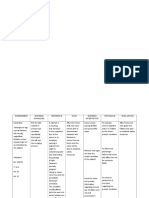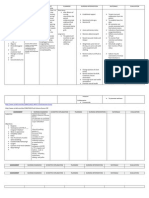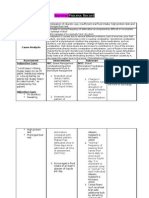Kristyn Joy D. Atangen October 25, 2020 BSN IV/ Section A/ Group D Josephine Minger Fdar Pedia
Kristyn Joy D. Atangen October 25, 2020 BSN IV/ Section A/ Group D Josephine Minger Fdar Pedia
Uploaded by
Tyn TynCopyright:
Available Formats
Kristyn Joy D. Atangen October 25, 2020 BSN IV/ Section A/ Group D Josephine Minger Fdar Pedia
Kristyn Joy D. Atangen October 25, 2020 BSN IV/ Section A/ Group D Josephine Minger Fdar Pedia
Uploaded by
Tyn TynOriginal Title
Copyright
Available Formats
Share this document
Did you find this document useful?
Is this content inappropriate?
Copyright:
Available Formats
Kristyn Joy D. Atangen October 25, 2020 BSN IV/ Section A/ Group D Josephine Minger Fdar Pedia
Kristyn Joy D. Atangen October 25, 2020 BSN IV/ Section A/ Group D Josephine Minger Fdar Pedia
Uploaded by
Tyn TynCopyright:
Available Formats
Kristyn Joy D.
Atangen October 25, 2020
BSN IV/ Section A/ Group D Josephine Minger
FDAR-PEDIA
F-Fluid volume deficit related to loose watery stool as evidenced by decreased urine
output, tenting skin turgor, increased blood pressure, and increased pulse rate
D-A 4.5-month-old female an alert but irritable and ill-appearing infant. The infant was
reported to have had 10 watery stools over the previous 24 hours, during which she became
quite unsettled, crying a lot, whilst drinking half her usual amount of liquids. There was no
history of vomiting. Skin was pale grey, tenting skin turgor, dry lips and dry buccal mucosa,
normal looking eyes but reduced tears, soft fontanele, and capillary refill time of 3 seconds.
The urine output was also decreased. Heart and lung examination were normal except for
tachycardia, the abdomen was swollen and slightly painful on palpation, no
hepatosplenomegaly. Abdominal and thorax radiographs were normal. There were no signs of
meningeal irritation. Upon checking for her Laboratory tests it reveals altered results. Vital
signs as follows: temp of 39.9°C; HR between 170 and 190 bpm; RR between 40 and 80bmp;
BP of 102/55 mmHg; Oxygen saturation by pulse oximetry of 100% and a weight of 3.99 kg
upon admission.
A-Monitor vital signs, including temperature, pulse and respiration. Note strength of
peripheral pulse. Measure blood pressure and capillary refill. Assess presence of physical
signs like dry mucous membranes and poor skin turgor. Assess change in usual mentation,
behavior or functional abilities like lethargy and dizziness. Observe urinary output, color,
and ,measurement. Review laboratory data. Assist with treatment of underlying conditions
contributing to drhydration and electrolyte imbalances. Administer fluid and electrolytes, as
indicated. Provide frequent oral hygiene to dehydrate mucous membrane. Change position
frequently. Provide safety measures. Replace electrolytes as ordered. Discuss factors related
to occurrence of deficit to the Parents. Instruct and encourage mother to maintain
breastfeeding to help meet specific fluid needed. Instruct SO on how to monitor color of urine
and how to measure and record I & O (by counting diapers of the infant). Instruct in
medication regimen, administration and interaction and side effect. Instruct signs and
symptoms indicating need for immediate or further evaluation.
R-Infant progressed toward desire outcome and Mother is receptive to health teachings
You might also like
- I. Project Title: University of The Cordilleras College of Nursing Project Proposal Community Health Nursing Level IvDocument4 pagesI. Project Title: University of The Cordilleras College of Nursing Project Proposal Community Health Nursing Level IvTyn Tyn50% (2)
- Muscle Maximum Growth IIDocument116 pagesMuscle Maximum Growth IIAlex Antoniou88% (16)
- Fdar CompilationsDocument3 pagesFdar Compilationsjp_ibañez67% (3)
- Fdar Charting (Umali)Document6 pagesFdar Charting (Umali)NicholeGarcesCisnerosNo ratings yet
- FdarDocument5 pagesFdarJoseph Raymund Fabian Huelar0% (1)
- Focus Charting: Date: Time: F Skin Integrity D Patient Is AwakeDocument1 pageFocus Charting: Date: Time: F Skin Integrity D Patient Is AwakeAngelica Mae Adlawan DesalesaNo ratings yet
- FDARDocument2 pagesFDARRoxanne Ganayo ClaverNo ratings yet
- SOAPIEDocument4 pagesSOAPIEdhianne_garcia2001No ratings yet
- .FDAR-Ineffective Airway Clearance. ManaoisDocument1 page.FDAR-Ineffective Airway Clearance. ManaoisDan Dan ManaoisNo ratings yet
- Case Study (Iph) Amoebiasis Diarrhea With Mild DHNDocument9 pagesCase Study (Iph) Amoebiasis Diarrhea With Mild DHNLance_Joshua_7907No ratings yet
- Actual Nursing Care Plan 2Document16 pagesActual Nursing Care Plan 2Alyanna Evangelista100% (2)
- Water Kangen USA MagazineDocument34 pagesWater Kangen USA MagazineWaterKangenUSA100% (22)
- Case PresentationDocument24 pagesCase PresentationSumit Yadav0% (1)
- Name: Nornisah H. Pangandaman Section: BSN 2A Fdar Date & Time Focus Data Action ResponseDocument2 pagesName: Nornisah H. Pangandaman Section: BSN 2A Fdar Date & Time Focus Data Action ResponseNornisah H. PangandamanNo ratings yet
- Date & Time Focus Data, Action & ResponseDocument1 pageDate & Time Focus Data, Action & ResponseKim DegamoNo ratings yet
- Date and Time Focus Data Action Response 1-11-13 8am Subjective: "Document2 pagesDate and Time Focus Data Action Response 1-11-13 8am Subjective: "Maria ReginaNo ratings yet
- SAMPLE FDAR CHARTING PainDocument1 pageSAMPLE FDAR CHARTING Painjpm100% (1)
- NCP Fdar Fin.Document8 pagesNCP Fdar Fin.Bissette DomingoNo ratings yet
- Post-Thyroidectomy FdarDocument1 pagePost-Thyroidectomy FdarKim Glaidyl BontuyanNo ratings yet
- PQRST Mnemonics AssessmentDocument2 pagesPQRST Mnemonics AssessmentKarel LuNo ratings yet
- 2019 Focus Charting FDARDocument15 pages2019 Focus Charting FDARGrape JuiceNo ratings yet
- FdarDocument4 pagesFdarCecile DavantesNo ratings yet
- Disseminated Intravascular Coagulation: Date/Time F Focus D Date A Action R ResponseDocument11 pagesDisseminated Intravascular Coagulation: Date/Time F Focus D Date A Action R ResponseMJ LomuntadNo ratings yet
- Saldana - Fdar Lung CancerDocument2 pagesSaldana - Fdar Lung CancerMika SaldañaNo ratings yet
- That May Used in Neurological Ward: Miguelito M. GultianoDocument32 pagesThat May Used in Neurological Ward: Miguelito M. GultianoLecery Sophia WongNo ratings yet
- Mendoza, Joshua G.Document7 pagesMendoza, Joshua G.Joshua MendozaNo ratings yet
- Nurses' Notes and Treatment Record: Date/Time Focus Progress Notes (D-Data A-Action R-Response)Document2 pagesNurses' Notes and Treatment Record: Date/Time Focus Progress Notes (D-Data A-Action R-Response)Jamie Lee100% (2)
- Focus Charting Nasal PolypDocument6 pagesFocus Charting Nasal PolypSj Eclipse100% (2)
- College of Health Sciences: Urdaneta City UniversityDocument7 pagesCollege of Health Sciences: Urdaneta City UniversityDan Dan ManaoisNo ratings yet
- Fdar For Indwelling Foley CatheterDocument1 pageFdar For Indwelling Foley CatheterRoan-Lhieyne Sagli Diad VenancioNo ratings yet
- 1 Ineffective Breathing PatternDocument8 pages1 Ineffective Breathing PatternNoel MontemayorNo ratings yet
- Date and Time Focus: D - Received Patient On BedDocument2 pagesDate and Time Focus: D - Received Patient On BedGraphaiene Neika WacasNo ratings yet
- NCP For DehydrationDocument1 pageNCP For Dehydrationjxhel63% (8)
- Lifestyle Modification: Asterlyn T. Coniendo Bsn-IvDocument4 pagesLifestyle Modification: Asterlyn T. Coniendo Bsn-IvAsterlyn ConiendoNo ratings yet
- Fdar Charting Date & Time Focus Progress Notes: DataDocument2 pagesFdar Charting Date & Time Focus Progress Notes: DataElaine dadaNo ratings yet
- FDARDocument1 pageFDARRona-Gloria Selma-Lopez100% (1)
- FDAR Charting - SurgicalDocument1 pageFDAR Charting - SurgicalWyen CabatbatNo ratings yet
- Fdarcharting 120314214902 Phpapp02Document5 pagesFdarcharting 120314214902 Phpapp02John Louie SolitarioNo ratings yet
- Ineffective Breathing Pattern As Evidenced by Use of Accessory Muscles and Episodes of DyspneaDocument3 pagesIneffective Breathing Pattern As Evidenced by Use of Accessory Muscles and Episodes of DyspneaNiel MinatozakiNo ratings yet
- Assessment Diagnosis Goals and Objectives Planning Intervention Rationale EvaluationDocument3 pagesAssessment Diagnosis Goals and Objectives Planning Intervention Rationale EvaluationCrissa AngelNo ratings yet
- Grand Case Pres FDARDocument11 pagesGrand Case Pres FDARMika SaldañaNo ratings yet
- FdarDocument1 pageFdarRoxas Cedrick100% (1)
- NCP Blurred VisionDocument3 pagesNCP Blurred Visionناديه المعمريNo ratings yet
- FDAR Charting 2 Date/Ti Me Focus DAR Acute Confusion DataDocument1 pageFDAR Charting 2 Date/Ti Me Focus DAR Acute Confusion DataMaria Chrislyn Marcos GenorgaNo ratings yet
- Fdar-Tachycardiac - GarciaDocument2 pagesFdar-Tachycardiac - Garciakkd nyle0% (1)
- Fdar HandleDocument2 pagesFdar HandleNicole Elma Caparas100% (4)
- Patient Name: Lorna Dimagiba Age: 84 Years Old Gender: Female C.S: Widow BED#: #1Document3 pagesPatient Name: Lorna Dimagiba Age: 84 Years Old Gender: Female C.S: Widow BED#: #1Girlie MebañaNo ratings yet
- NCP UtiDocument1 pageNCP UtiElaisa Mae Delos SantosNo ratings yet
- FDARDocument2 pagesFDARRafael Basa100% (1)
- 12/07/20 3PM-11PM: Fdar ChartingDocument5 pages12/07/20 3PM-11PM: Fdar ChartingElle ctricaNo ratings yet
- Physical Exam - AppendectomyDocument8 pagesPhysical Exam - Appendectomyirish felixNo ratings yet
- Fdar - 2 HypertensionDocument12 pagesFdar - 2 HypertensionGinena Belarmino100% (3)
- Fdar 3Document2 pagesFdar 3Loungayvan BatuyogNo ratings yet
- Charting NotesDocument4 pagesCharting NotesjisooNo ratings yet
- Focus Data ChartingDocument3 pagesFocus Data ChartingcattleyaNo ratings yet
- NCP Ineffective Airway Clearance Related To Presence of Secretion in Trachea-Bronchial Tree Secondary To History of CAPDocument2 pagesNCP Ineffective Airway Clearance Related To Presence of Secretion in Trachea-Bronchial Tree Secondary To History of CAPpa3kmedina100% (1)
- NCPDocument3 pagesNCPranee diane0% (1)
- Altered Sleeping PatternDocument4 pagesAltered Sleeping PatternIan Kenneth Da SilvaNo ratings yet
- Labor Room Soap ChartingDocument1 pageLabor Room Soap ChartingKatrisha Angelica EncarnacionNo ratings yet
- NCP FinalDocument18 pagesNCP FinalHelen GonzalesNo ratings yet
- Focus Data Action ResponseDocument3 pagesFocus Data Action ResponseSitty Aizah MangotaraNo ratings yet
- NCP Format 3 CKD Chronic Kidney Disease DM Diabetes Mellitus NephropathyDocument3 pagesNCP Format 3 CKD Chronic Kidney Disease DM Diabetes Mellitus NephropathyAngie MandeoyaNo ratings yet
- Skills Subj and ObjDocument3 pagesSkills Subj and ObjDimple Castañeto CalloNo ratings yet
- Case Study Group 2 Chapter 21Document4 pagesCase Study Group 2 Chapter 21Arnold ZamoroNo ratings yet
- NCP DengueDocument4 pagesNCP DengueJanna Carrel Isabedra Rodio100% (2)
- Eye Problems Stroke Kidney Disease Heart Disease Arthritis Nerve and Blood Vessel ProblemsDocument2 pagesEye Problems Stroke Kidney Disease Heart Disease Arthritis Nerve and Blood Vessel ProblemsTyn TynNo ratings yet
- Atangen CHN Journal CariagaDocument2 pagesAtangen CHN Journal CariagaTyn TynNo ratings yet
- Name: Kristyn Joy D. Atangen Date: November 13, 2020 Group: BSN Iv/ A-D Name of CI: Marlene J. AnacioDocument2 pagesName: Kristyn Joy D. Atangen Date: November 13, 2020 Group: BSN Iv/ A-D Name of CI: Marlene J. AnacioTyn TynNo ratings yet
- Explanation & Discussion:: The Harmful Effects of AlcoholDocument10 pagesExplanation & Discussion:: The Harmful Effects of AlcoholTyn TynNo ratings yet
- CA1 Notes - 082520Document1 pageCA1 Notes - 082520Tyn TynNo ratings yet
- 13 Areas of AssessmentDocument3 pages13 Areas of AssessmentTyn TynNo ratings yet
- CHN - Case Study 2 - 111920Document2 pagesCHN - Case Study 2 - 111920Tyn TynNo ratings yet
- CHN - Case Study 1 - 111920Document2 pagesCHN - Case Study 1 - 111920Tyn Tyn100% (1)
- (Obesity & Over Weight), (Overweight, Obesity, & Depression A Systematic Review and Meta-Analysis of Longitudinal Studies)Document3 pages(Obesity & Over Weight), (Overweight, Obesity, & Depression A Systematic Review and Meta-Analysis of Longitudinal Studies)Tyn TynNo ratings yet
- Name: Kristyn Joy D. Atangen Date: November 19, 2020 Group: BSN Iv/ A-D Name of CI: Shirlynne AlbacioDocument2 pagesName: Kristyn Joy D. Atangen Date: November 19, 2020 Group: BSN Iv/ A-D Name of CI: Shirlynne AlbacioTyn TynNo ratings yet
- Diagnostic Significance of EnzymesDocument1 pageDiagnostic Significance of EnzymesTyn TynNo ratings yet
- Oxygen Administration ScriptDocument2 pagesOxygen Administration ScriptTyn TynNo ratings yet
- What Are The Different EvidenceDocument1 pageWhat Are The Different EvidenceTyn TynNo ratings yet
- Classification of Genetic DiseasesDocument8 pagesClassification of Genetic DiseasesTyn TynNo ratings yet
- Experiment No. 2 PH and BufferDocument7 pagesExperiment No. 2 PH and BufferTyn TynNo ratings yet
- I. Data Table Solubility Test: Experiment No. 3 LipidsDocument3 pagesI. Data Table Solubility Test: Experiment No. 3 LipidsTyn TynNo ratings yet
- Experiment No. 5 Study of Enzymes: Data TableDocument3 pagesExperiment No. 5 Study of Enzymes: Data TableTyn TynNo ratings yet
- Experiment No. 4 Proteins and Amino Acid: I. Data TableDocument3 pagesExperiment No. 4 Proteins and Amino Acid: I. Data TableTyn TynNo ratings yet
- I. Data Table A. Physical Properties: Experiment No. 6 UrineDocument6 pagesI. Data Table A. Physical Properties: Experiment No. 6 UrineTyn TynNo ratings yet
- Kristyn Joy D. Atangen Mc1 LecDocument2 pagesKristyn Joy D. Atangen Mc1 LecTyn TynNo ratings yet
- NAME: Kristyn Joy D. Atangen DATE: Oct. 7, 2019: Subjective: DXDocument2 pagesNAME: Kristyn Joy D. Atangen DATE: Oct. 7, 2019: Subjective: DXTyn TynNo ratings yet
- Pedia NCPDocument9 pagesPedia NCPTyn TynNo ratings yet
- I. Data Table: Experiment No. 2 CarbohydratesDocument3 pagesI. Data Table: Experiment No. 2 CarbohydratesTyn TynNo ratings yet
- Children With Bronchiolitis: A Meta-Analysis of Randomized Controlled TrialsDocument3 pagesChildren With Bronchiolitis: A Meta-Analysis of Randomized Controlled TrialsTyn TynNo ratings yet
- I. TITLE: What Is Developmental Dyslexia? AUTHOR: John Stein Source: YEAR OF PUBLICATION: February 4, 2018Document3 pagesI. TITLE: What Is Developmental Dyslexia? AUTHOR: John Stein Source: YEAR OF PUBLICATION: February 4, 2018Tyn TynNo ratings yet
- NAME: Kristyn Joy D. Atangen: Subjective: DXDocument5 pagesNAME: Kristyn Joy D. Atangen: Subjective: DXTyn TynNo ratings yet
- Pedia Drug StudyDocument5 pagesPedia Drug StudyTyn TynNo ratings yet
- A Nursing Care For Children With Diarrhea DiseasesDocument27 pagesA Nursing Care For Children With Diarrhea DiseasesMeita Ratri100% (1)
- MBBS Medical Questions and Answers On DiabetesDocument24 pagesMBBS Medical Questions and Answers On DiabetesabcdmedsNo ratings yet
- Essay 1 - Draft 1Document5 pagesEssay 1 - Draft 1api-643551204No ratings yet
- NCPDocument9 pagesNCPpeterjongNo ratings yet
- Cheat Sheet (AutoRecovered)Document2 pagesCheat Sheet (AutoRecovered)Garry LeeNo ratings yet
- Measles Management Guidelines - 091222-1Document14 pagesMeasles Management Guidelines - 091222-1Tushar AmbedareNo ratings yet
- Hope 1 - FitnessDocument13 pagesHope 1 - FitnessMark Clemence R. ParcasioNo ratings yet
- Nausea: Definition: A Subjective Unpleasant, Wavelike Sensation in The Back of The Throat, EpigastriumDocument14 pagesNausea: Definition: A Subjective Unpleasant, Wavelike Sensation in The Back of The Throat, EpigastriumK Jayakumar KandasamyNo ratings yet
- PNEUMONIADocument8 pagesPNEUMONIARica ParcasioNo ratings yet
- Healthcare Professional (HCP) - Basic Life Support (BLS) Certification CourseDocument26 pagesHealthcare Professional (HCP) - Basic Life Support (BLS) Certification CourseJessica Nelly Davila CastellanosNo ratings yet
- New - Menu The Drip Club IV OnlyDocument18 pagesNew - Menu The Drip Club IV OnlyDrip ClubNo ratings yet
- Nursing Process Record 3Document6 pagesNursing Process Record 3Trexia Ann BayetaNo ratings yet
- US Field Manual SurvivorDocument473 pagesUS Field Manual Survivorbubinstein100% (1)
- Drug Study MedicationsDocument10 pagesDrug Study Medicationsamal abdulrahmanNo ratings yet
- Nursing Care Plan: IndependentDocument2 pagesNursing Care Plan: IndependentAdhaNo ratings yet
- 00 Renal FabsDocument9 pages00 Renal FabsAngelica AlayonNo ratings yet
- Nursing Diagnosis For Imperforated AnusDocument1 pageNursing Diagnosis For Imperforated AnusAndrea Huecas Tria83% (6)
- NCP3 Skin IntegrityDocument3 pagesNCP3 Skin IntegrityAngela NeriNo ratings yet
- Module 20 Thermoregulation: Nursing: A Concept-Based Approach To Learning, 2e (Pearson)Document30 pagesModule 20 Thermoregulation: Nursing: A Concept-Based Approach To Learning, 2e (Pearson)RNStudent1100% (1)
- NEO Scavenger - Manual PDFDocument37 pagesNEO Scavenger - Manual PDFFilha Do ReiNo ratings yet
- CRF - Bacillus Clausii + ORS + ZincDocument7 pagesCRF - Bacillus Clausii + ORS + ZincNarendar ReddyNo ratings yet
- B. Nursing Care PlanDocument3 pagesB. Nursing Care PlanDane YelNo ratings yet
- NURSING CARE PLAN - Risk For Fluid Volume DeficitDocument2 pagesNURSING CARE PLAN - Risk For Fluid Volume DeficitDaniel Andre S. SomorayNo ratings yet
- The Healing Power of Water: An Exclusive Interview With Dr. BatmanghelidjDocument18 pagesThe Healing Power of Water: An Exclusive Interview With Dr. BatmanghelidjErwin PadillaNo ratings yet
- Nutrition and Dietetic Recommendarions in TaekwondoDocument30 pagesNutrition and Dietetic Recommendarions in TaekwondoLatifah ZahrohNo ratings yet
- Who Dehidrasi PG 17 PDFDocument52 pagesWho Dehidrasi PG 17 PDFSasha ManoNo ratings yet





















































































































